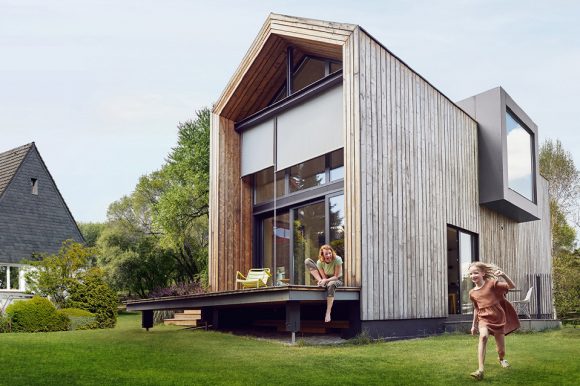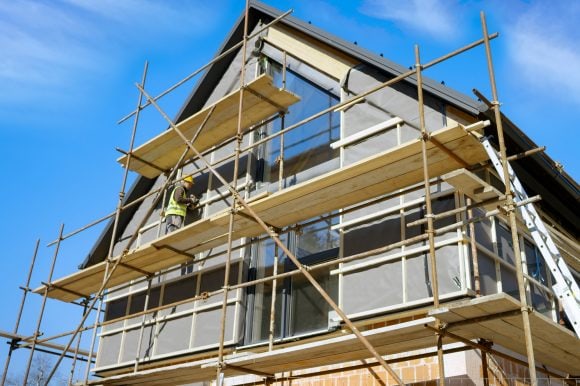We’re here for you
Arrange an appointment for a non-binding consultation or if you have any questions, just give us a call.

![]()
header.search.error
Renovation or replacement?
Replacement constructions are more economical, have a better energy balance and a higher densification potential. Because you can plan them according to your own ideas, they can often be adapted to suit your personal lifestyle.
Content:

Since there is very little undeveloped land in Switzerland, buying a plot of land often means buying an older property at the same time. The same applies to the inheritance of a house. In both cases the key question is: should you renovate the existing construction or demolish it and build a new one? The latter is referred to as a replacement construction. If you choose this option, there are various factors to consider.
We explain when a replacement construction is worth it, and when it is not.
In many parts of Switzerland, replacement construction has become increasingly important. According to the latest real estate analyses by consulting firm Wüest Partner, this trend is most apparent in large city centers. In Zurich, Geneva, Basel, Bern, Lausanne and St. Gallen, around half of all new apartments are replacement constructions, while new buildings on as-yet undeveloped plots tend to be the exception.
In terms of regions, this is most obviously true in Zurich, Thun, Nyon and Yverdon . But even in peripheral locations and in medium-sized towns, the amount of replacement construction has grown considerably and is particularly high in popular tourist areas in the canton of Graubünden, for example in and around Davos. Note, however, that in touristic areas, the construction of new vacation homes or second homes is either heavily restricted or not possible at all.
Inward development
In cities, the reasons are different: land is in extremely short supply. At the same time, most construction and zoning regulations allow densification of existing plots. In many cantons, such as St. Gallen, Zurich or Zug, new zoning of development land is virtually impossible or is subject to heavy restrictions. The vast majority of regions have designed their structure plans, land-use planning and zoning regulations according to the maxim “inward development.” For owners of existing buildings, this is an advantage because today’s regulations allow a small apartment block or a project with row houses to be built on many building plots with a detached home from the 1960s or 1970s.
Reasons for replacement construction
There are three solid reasons for replacement construction:
First, they enable a major increase in usable space on the same area of land. For owners, the potential is considerable. If the properties are rental apartments, yields increase significantly.
Second: Sometimes older homes are in such poor condition that there’s no better alternative.
Third, in today’s environment, energy efficiency is a big factor. Energy consumption for heating and hot water is four to five times lower for a high-quality new construction than for a home from the 1970s.
However, owners must also consider the expense and total costs involved. The necessary planning work, demolition and disposal as well as the construction of the new house can be expensive. As a rule of thumb, the construction costs alone for a house are 3,300 francs per square meter.

Free real estate appraisal included
Benefit from an interest rate reduction of 0.30% on your first home with UBS

0.30% eco-bonus
Then take advantage now of particularly attractive interest rates and our eco-bonus with the UBS “Renovation” mortgage.
Working out how much flexibility you have
Before architects start drawing up their plans and visions for a construction plot, the situation regarding construction regulations must first be thoroughly researched. Even though privately owned buildings are rarely listed buildings, many places of historical interest in cities and medium-sized towns are protected to some degree. If the property is located in such a zone, the possibilities of making significant changes are limited, just as in the case of residential buildings subject to a protection or preservation order.
More and more cantons and cities are making information on building and zone regulations, historic monuments and inventories of historic buildings publicly available on their online geoportals. If you cannot find the information you’re looking for there, try contacting the responsible building authority directly.
In most cases, only once you have this information is it worth consulting an architect for a thorough assessment of applicable building regulations, and an initial study of different options. Architects are trained to explore the best options allowed by building and zone regulations and to put forward concrete proposals.
Tailor-made financing for a new building or renovation
As soon as a decision is made, you’ll need to estimate costs and arrange the financing. To do so, contact your UBS client advisor at an early stage. For major renovations, new buildings or replacement constructions, we recommend UBS Building Financing. You can use the building account to pay all current invoices from architects, construction companies and contractors. The financing solution is based on your individual needs and gives you full cost transparency during every phase of your project.
With the building loan offered by UBS, you have access to a building account where all costs related to your dream of home ownership can be managed.
Replacement construction: step by step in 10 points
The choice between renovation or replacement construction is primarily based on two criteria: what is more economic, and what fits your lifestyle better?
You should calculate costs very carefully. A new building requires considerable financial resources and is often more expensive than the renovation of an old building. However, new buildings can often achieve energy efficiency standards that can either not be achieved at all in existing buildings or only with a lot of investment. Due to the permanently lower energy costs, the high investment can nevertheless pay off in the long term.
With a new building, individual design wishes - such as large windows and spacious rooms - can also be realized. The creative freedom is usually greater than in the case of a renovation. Whether this justifies the cost of a new building is a very individual decision.
No matter your decision: our experts will advise you on the realization and financing of your plans.
Arrange an appointment for a non-binding consultation or if you have any questions, just give us a call.
Disclaimer